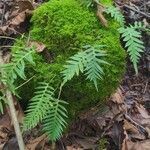A fern. It grows attached to other plants. It grows 30-60 cm high and spreads 30-60 cm wide. It loses its leaves in summer. The rhizomes are shallow and branching. They are yellowish-green and 6 mm thick. The fronds are 35 cm long. They are thin and sword shaped and have 10-20 offset pointed segments.

